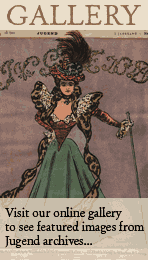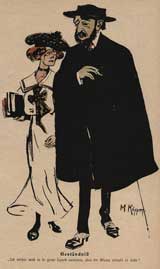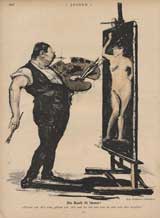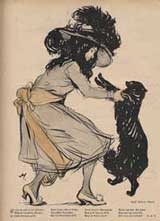The Beginning of a Legend
(continued from previous page)
Unlike many previous (and subsequent) art movements, Jugendstil art had a very martial quality at times. It was highly supportive of Germany's history and extremely patriotic and supportive of Germany as a nation. When World War I began, Jugend's pages changed radically. The domestic or magical scenes on the cover gave way to war-themed illustrations, generals, and art that enthusiastically supported the war in subtle ways. Though little of the art even now was truly militaristic, it did show citizens enthusiastically involved in military service for either Germany or Austria. Interestingly, many of the artworks between 1914 and 1918 were created by gifted amateurs.
Even in these war years, though, Jugend was primarily devoted to art and the publication of art. Readers still found their gorgeous fairy tales, their fanciful landscapes, and their moody scenes.
Alas, nothing lasts forever. After a long and fruitful period of two decades editing the paper he had founded, Georg Hirth died in 1916, in the middle of World War I. He left behind at the magazine an unstable management, economic difficulties, and a lack of editorial vision. Jugend was frequently on the brink of ending for several years, but in 1927 it found its footing again under the leadership of Franz Schoenberner, and published in Nazi Germany until it was discontinued in 1940.
It was a different magazine when Schoenberner resurrected it. Before, Jugend had been an optimistic, joyful publication. Afterward, it became more sharply intellectual, sceptical and satirical. This was almost certainly due in part to the harsh conditions of the Treaty of Versailles against Germany. Instead of the lively, hopeful nation it had been before the war, Germany was broken and broke, a country with many economic woes and not much energy to spend on sentimentalism and art. It worsened over time; after 1933, under the influence and control of the Nazi party, Jugend was forced to give up most of the ideals it had been built on to make way for propaganda and Nazi censorship. It continued publication, nevertheless, until 1940.






